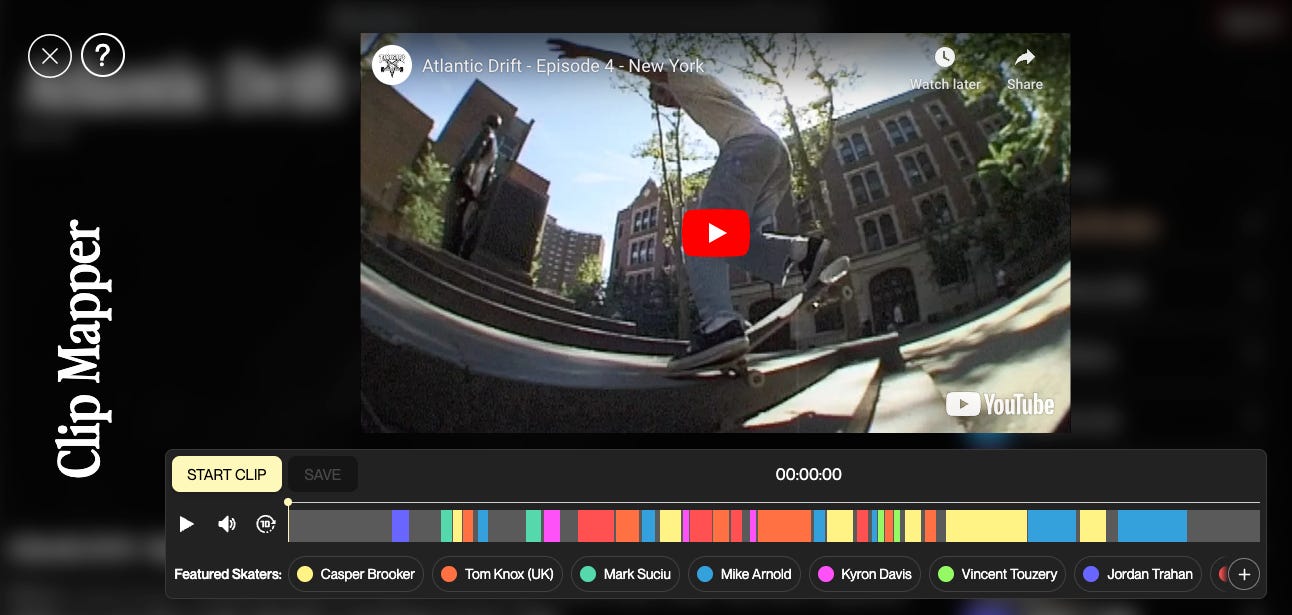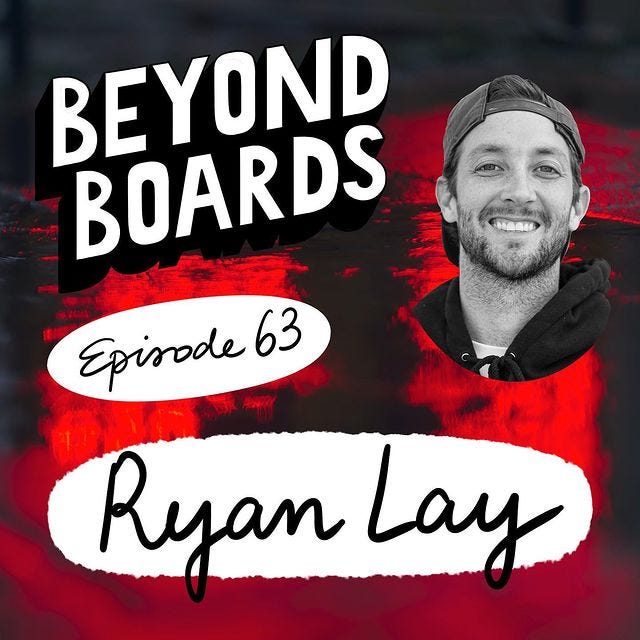A struggle of context and meaning | Simply Ranked
Plus: Do more and get paid less, skate media innovations, a game of V.I.L.L.A.I.N., and more.
The definitive weekly ranking and analysis of all the skateboarding and other online things that I cannot stop consuming and how they make me feel, personally.
Do more, get paid less
Rank: Mmm, not good
Mood: 💸
“[Professional skateboarding is] hard. It’s hard as fuck. The modelling shit helps me pay for a lot of my bills, more so than skateboarding. I’ve had moments where I’m broke as shit and not eaten, but I’ve never questioned it. I just love it too much.” Carlisle Aikens says in a recent “Diaries” feature by Hypebeast.
I’d like to offer a counterpoint if I may: maybe we should question it! Why is one of the bigger names in skateboarding, who’s PRO for a legacy brand in Chocolate Skateboards and rides for adidas, unable to afford food? That doesn’t seem great. Are these brands’ budgets for their skate teams really that small? Are sales on such a decline that they can’t pay the skaters whose job it is to represent them a living wage? How much do PRO and AM skateboarders get paid anyway? Ah, that’s right, there’s an industry-wide avoidance of making those numbers public in any meaningful way.
Is that purposeful? Probably. Professional skateboarders are, by design, independent contractors. That means their “employment” is always precarious, can be severed at any time, and they generally have no access to employer-provided benefits of any kind in a profession with inherent physical risk — so why would companies change things when it seems to be working out for them just fine? That’s part of what makes organizing any sort of labour union or guild difficult: no one is technically an employee of the companies that sponsor them and it would require unprecedented unity and sacrifice from skaters to move anything in the industry.
However, that doesn’t mean it shouldn’t be tried. With a wave of recent labour victories in the United States, from the WGA to this week’s historic UAW deal, there’s momentum. But how do you get something moving in an industry that’s never made any serious headway on the issue? A first step in any direction is a start. Perhaps if there were more clarity on what skaters get paid, there would be more drive for collective action. Or, at the very least, it would give skaters more leverage when negotiating contracts.
Because if Carlisle Aikens can’t make a living, then who beyond the top 10-15 skaters in the industry can?
A cure for namelessness
Rank: 1
Mood: 📊 📈
A couple of weeks ago, I mused about starting a shared Google Sheet that catalogues every trick everyone has ever done in every video (existing or forthcoming) in an effort to curtail embarrassing ABDs. While I was being a Silly Little Guy by suggesting that, I received an email last week from photographer and skateboarder Josh Katz, who has been working on something that is actually way cooler and more useful.
Katz and a team of engineers have been building Skatefolio, which he describes as “an interactive database for skate videos.” The Skatefolio site goes further, “Ever wonder who the skater was in that untitled Bronze 56k video? Want to watch every clip Jake Johnson's ever filmed? Curious to see Ben Chadourne's complete filmography? With our Clip Mapper tool, beautiful profiles, and a robust database, we're on a mission to give credit where credit is due.”
It’s still in its invite-only stage, but I’ve played around with it a bit, and it seems pretty interesting. Is it a cure for ABDs and the scourge of anonymous skaters in videos? Perhaps! I imagine you can do some other fun stuff with it, too. This, along with what my pals at the den are doing, made me realize that there’s some real headway being made to innovate the way we consume and think about skateboarding media, which I think is pretty cool.
Also, full disclosure: I curated a Simple Magic playlist for the den. I didn’t get paid for it or anything; I just wanted to disclose it so you’d go and watch.
A game of V.I.L.L.A.I.N.
Rank: 1.1
Mood: G.O.O.D.
It could, if you squint, be considered successful brand marketing on Cariuma Footwear’s part for me to be so invested in the Battle At The Berrics match between Cariuma rider Cody Cepeda and two-time SOTY Chris Cole. Not because I’m rooting for Cepeda, mind you (though he does seem like a nice person), but because I am actively invested in seeing Cariuma fail. Is that petty and based on nothing more than my own brand allegiances and perceptions of what is “cool?” Absolutely.
Also, I should clarify. I don’t want to see the brand go out of business. They provide a lifeline for professional and amateur skateboarders who can’t find shoe sponsors anywhere else, which is an essential role for a company in the industry to occupy. And they must pay… decent (would be nice to know, huh)? At least enough to score Luan Oliveira post-Nike, however much juice you think he may have left. That extra income offers PROs on the apparent decline, like Oliveira, an off-ramp, a path to continue their careers even if they’re likely coming to an end. It’s also significant for the good-but-not-currently-marketable AM to help kickstart their career (although I’m not sure if we’ve seen anyone move onwards and upwards from Cariuma yet).
That doesn’t mean I can’t talk my shit, though. That’s a vital part of following and enjoying professional athletics. You get to be invested in storylines, trades, sponsors, etc. Cariuma being a dork brand is a narrative I am fully invested in. Plus, Steve Berra of The Berrics, serving as a brand manager of sorts for Cariuma (though his role has never been fully and publically defined), likely explains why the BATB tournament roster was stacked with Cariuma riders and why Cariuma is the presenting sponsor for the second year in a row — clearly, the fix is in. So, what’re you going to do, root for the man? That’s why I’m backing Chris “Cobra” Cole, rider for Argentine Fallen Footwear, to win BATB to spite them.
All of that to say, for Cariuma to take up this much of my mindspace, even if it’s negative, is a form of success. The “all attention is good attention” tenet. Nothing wrong with being the villain. Look at Dillon Brooks; people love to hate on that guy, yet he brings in eyeballs (especially when he gets cooked). That’s the other part of the role this shoe brand plays: the heel. The best we can hope for is for the Cariuma riders to lose in the finals. Imagine the explosion of positive sentiment if aged Chris Cole gets past Nick Holt and then brings home the victory against Tyler Peterson or Oliveira (who’re on the other side of the bracket) — he’ll have staked Dracula. Destroyed the Deathstar. People love that shit, me included.
Something else I love and that’s sort of related? Gifted Hater’s Sci Fi Game of S.K.A.T.E. vlog. Nothing like a good vlog, you know?
A struggle of context and meaning
Rank: 2
Mood: 🤼
On Saturday, Thrasher uploaded the latest entry in their “My War” series, focusing on the monumental struggle David Reyes faced before riding away from his 360-flip-noseblunt-slide down Clipper in 2021. His “War” included a total of six trips, double-digit hours spent throwing himself at the iconic hubba ledge, untold hours spent training the trick on skatepark hubbas, and one assault and theft that resulted in videographer Dan Stolling getting knocked unconscious with the butt of a gun and their camera gear stolen before Reyes eventually rolled away.
Then, on Sunday, Thrasher held their “Bust or Bail: Ripper at Clipper 2” event. It featured some of today’s best skateboarders doing some of the gnarliest tricks ever done at Clipper in a matter of hours, some in full costume. Switch-heelflip-back-50, kickflip-backside-noseblunt, nollie-270-noseslide, switch-270-frontblunt. The level of skateboarding on display for an Instagram edit (and later a YouTube cut) was absurd.
In terms of a media strategy, it seems clear that Thrasher posted Reyes’ “My War” as a prelude to “Bust or Bail: Ripper at Clipper 2.” Perhaps to tease, hype, or provide extra context to the following day’s event — look how hard this thing is to skate, now watch people do a bunch of fucked up tricks on it. However, like with previous “Bust or Bails,” it makes me wonder if they actually devalue the iconic spots they look to venerate. Because when a place where generations of skateboarding lore took place becomes the location for a contest that gets broadcast in chunks on social media, the impact of something like Raimu Sasaki’s switch-270-frontblunt feels significantly less than it would be if it were in a video part and teased first in a magazine.
A few months back, I shared a similar sentiment after X Games hosted a contest at Rincon, of all places.
While a thoroughly entertaining watch, it was odd to think of this place known simply and somewhat frighteningly as “Rincon,” becoming a location where a gold medal could be won. The broadcast did a decent job explaining the gravity of what having an event here meant, using talking head interviews with Jamie Thomas, Chris Cole, and Chris Joslin to place the dull grey concrete bleachers in a historical perspective. But what does having an event like this here mean for the spot itself? Can a skate spot sell out? Are skateboarders going to want to try NBDs here now that the spot will likely get rebroadcast on ABC? Or had skaters already wrung out what was left of Rincon’s cultural impact over all these years and tricks, and this was the only way to resuscitate it?
That’s a lot of questions without definitive answers. What is concrete, however, is that Alec Majerus kickflip-frontside-nosegrinding Rincon’s rail in nine tries was absolutely messed up. But that begs another question: if someone does a trick at a street spot but in a contest setting, does it still count as a “street” trick?
Chris Cole, the recurring favourite of this week’s newsletter, switch-frontside-flipped and backside-360’d Wallenberg, but the trick that most often gets mentioned is his 360-flip down it. Is that because it was his ender in New Blood and the others were done at a “Bust or Bail?” Would Reyes’ 360-flip-noseblunt still become the career highlight it has if he’d landed it dressed as Raggedy Anne this past Sunday? On its face, it shouldn’t matter because the spot is still the spot; its dimensions haven’t changed. Yet, it feels different. There’s a lack of reverence in a contest or jam like this, no matter how wild and fun they are (and they are both of those things, to be sure).
Skateboarding media — full-length videos, video parts, magazines — are the highest honours we can bestow on the act of skateboarding. To give a trick the space to breathe and a place to live that we can return to as a marker of time and influence is the fullest potential it can reach. It’s how skateboarders create legacies and how we measure them. It’s why Darrell Stanton can go to “Bust or Bail: Ripper at Clipper 2” wearing a crown and no one questions why.
Carry despair like a football
Rank: N/A
Mood: N/A
After writing all of the words above these ones, this silly sustained pseudo-analysis of skateboarding and the habits, foibles, and intermittent beauty of this culture that we all share, I have to say that it’s never felt so pointless as it has these last few weeks. Not that it’s never not pointless, mind you. A skateboard is just a toy we’ve ascribed meaning to, after all. But it feels utterly rote to watch, write, and then post about “tricks” or “wack brands” as Western governments continue to condone and support Israel’s ongoing genocide against the Palestinian people.
Of course, it should be hard to carry on with your day-to-day as refugee camps get repeatedly bombed, death tolls climb, millions of people around the world march in support of a ceasefire and Palestinian liberation while major news outlets in the West send nary a reporter down, and McCarthy-esque censorship campaigns take root. It would be strange to feel normal right now. Historic atrocities are unfolding and we shouldn’t turn away.
Does that mean you shouldn’t also do the things you usually do, like riding in an overturned port-a-potty down a hill into a crowd of people? I don’t know. Do what’s best for you. I write this newsletter because it’s usually enjoyable and keeps me focused, so I’ll keep doing it for now.
What I do know is that if you also feel that crushing weight of despair, don’t let it hold you down. Carry it like a football — a thing imbued with purpose — and run with it. Call and email your local and federal representatives, attend demonstrations if you’re able, sign legitimate petitions that demand tangible action, and boycott companies that are complicit. Make your voice heard in the ways you can; it can affect change.
Something to consider: “Bearing Witness To Gaza’s Grief Shouldn’t Feel Like A Radical Act” by Samer Kalaf for Defector.
Good thing: Kevin Horn’s Perennial is now online for your viewing pleasure. It’s a beautiful video with lots of pals in it. Enjoy!
Another good thing: Jono Coote, a ripper of a writer and skateboarder, interviewed rippers of writers and skaters in Indigo Willing and Anthony Pappalardo about their book (that ‘sletter friend Adam Abada did illustrations for) Skateboarding, Power, and Change for Vague.
Ooh, another good thing!: It’s great to have Ben Raybourn back around the game and he got a masterful Chromeball treatment this week.
A poster’s invitation: Here are some Bluesky invites if you’re interested. First come, first post.
bsky-social-342s3-nm2wd
bsky-social-yjc4k-g6tcn
bsky-social-dspyz-4r7tl
bsky-social-gzu44-ymkw2
A podcast inclination: Sci-Fi game of S.K.A.T.E. contestant Ryan Lay is the latest guest on Beyond Boards.
Until next week… if you find yourself sitting on a park bench and reading a book as dogs scamper across the grass in pursuit of toys or friends or their humans, take a quick snapshot of the moment in your mind. Is the sun setting? Can you see your breath? Did a dog named Lily drop a ball at your feet with expectant fervour? Hold onto these moments for when you need them.
I wrote a book about the history and cultural impact of Tony Hawk’s Pro Skater, and I will keep posting about it at the end of the newsletter for the foreseeable future. Apologies. Right, Down + Circle is in stores now and you can also order it from your favourite local bookshop, my publisher ECW Press, or all of the usual devils (Amazon, Barnes & Noble). I think you might like it.
Also, if you like book clubs, you can join the inimitable Ted Barrow in reading Right, Down + Circle on his Berate The Birds Patreon, which you should also subscribe to because it rules. He’s almost through the thing now, so you’ve got some nice stuff to listen to while puttering around the house.
Also, also, the Birdman himself has finally read the book (or at least took a photo of it). So if that doesn’t convince you to buy it, that’s okay. There’s no pressure. I just appreciate you reading this newsletter.




















Your section titled: A struggle for meaning and context — was spot on, Cole. It does feel as though holding contests at iconic spots somehow dilutes the impact of the tricks that go down in those contests, as opposed to if they were in video parts.
Well said sir.